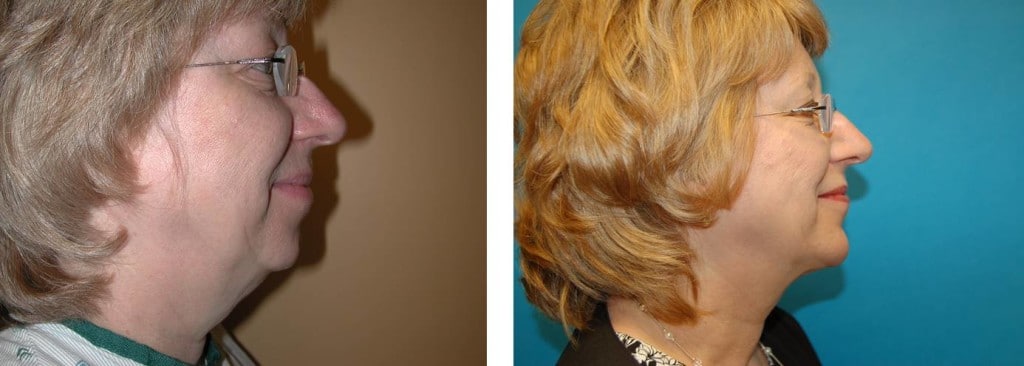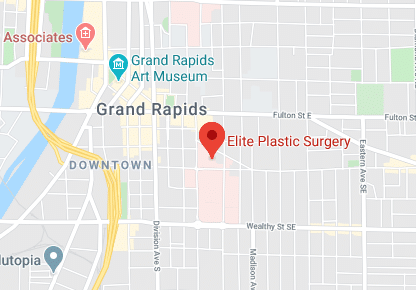What is a Chin Augmentation?
Procedures include the placement of silicone implants into the chin region or manipulation of the existing bony structure of the chin to produce a more prominent chin in an attempt to balance the facial structure. Incisions are often placed inside the mouth to minimize the appearance of scarring. The overall effect is a more balanced facial architecture. Complete healing usually takes several months.
Candidates for Chin Augmentation Surgery
Chin augmentation surgery may be appropriate for individuals with an underdeveloped chin. When we observe the side view profile of the face, what the eye looks for is a chin that projects as far forward as the lower lip. Less of a projection results in what we call a “weak chin.”
Another aspect of facial proportions lies between the chin and the nose. Individuals with a large or protruding nose or patients who undergo rhinoplasty to alter the shape and size of their nose often consider chin implant surgery as a commentary procedure to bring more harmony to the face.
Chin augmentation surgery can correct the weak chin and also minimize the appearance of a double chin and indistinct neck.
Chin Augmentation Before & After
*Individual results may vary
View more before & after photos»
Benefits of Chin Enhancement Surgery
Chin augmentation surgery can be a highly satisfying procedure because a strong chin has such a positive effect on the face. Women who strengthen their profile may look and feel more elegant. Increasing the projection and/or squareness of the male chin enhances the masculine traits of the face. Patients also appreciate the short duration of the augmentation procedure, the relatively short recovery period, and the fact that chin implants can be removed if so desired.
What Results Can Chin Augmentation Achieve?
Chin implant surgery doesn’t just contour the lower face, it creates cohesion between facial features to enhance overall beauty. A stronger chin with proper projection creates the triangular lower face that accentuates the profile. Ultimately, patients who undergo chin implant surgery express feeling more satisfied and confident about their appearance.
The Chin Augmentation Procedure
The chin augmentation procedure may be performed under local anesthesia and sedation or general anesthesia. This detail is determined during your consultation visit. During the outpatient procedure, the incision may be in the mouth or under the chin with minimal scarring. Space is created on top of the chin bone and the selected implant is inserted over the bony structure. The entire process is typically completed within approximately one hour.
Types of Chin Implants

Implant types vary by shape, with the most common being:
- Anatomic chin implant
- Extended anatomic chin implant
- Mild square implant
Implant sizes, shapes, and material type are all discussed during the consultation and are selected based on the desired outcome of surgery.
Alternatives to Surgical Chin Augmentation
Non-surgical chin augmentation may also be an option for some patients. This technique uses dermal fillers to temporarily enhance the contours of the chin and jawline. Dermal filler treatment is conducted in the office without the need for anesthesia.
Results of non-surgical chin enhancement may last from six months to 24 months depending on the product used and the speed at which hyaluronic acid breaks down in the patient’s body.
Chin Augmentation Recovery
The initial recovery from chin augmentation may last approximately one week. During the first 24 hours after surgery, some patients feel nauseous or groggy from anesthesia and pain medication. Soreness and tenderness may be somewhat uncomfortable for the first week. Prescription pain medication should be used as directed to manage comfort. Also within the first week, swelling may occur, making the chin appear uneven. As swelling subsides, the final outcome of augmentation will become noticeable.
Bruising and numbness are also side effects that may occur. These should diminish over a few weeks. Because numbness decreases awareness of temperature changes, patients should avoid placing ice directly on the skin after surgery. Some patients find that their speech is somewhat compromised for the first few days after their augmentation. This is not an indication of a surgical complication; it is a normal side effect that improves over time.
Risks of Chin Augmentation Surgery
Post-surgical complications are rare after chin augmentation surgery and, if they do occur, are typically easily resolved with prompt medical care. Surgical risks include poor wound healing, infection, blood clots, and adverse reaction to anesthesia. Unique risks associated with chin augmentation include malposition or shifting of the implant, prolonged numbness in the chin or lower lip, and over or under-correction. Chin augmentation should only be performed by a board-certified plastic surgeon.
Schedule a Consultation
If you are considering chin surgery and would like to find out if it is right for you, contact our office at(616) 459-1907 to schedule a consultation.



